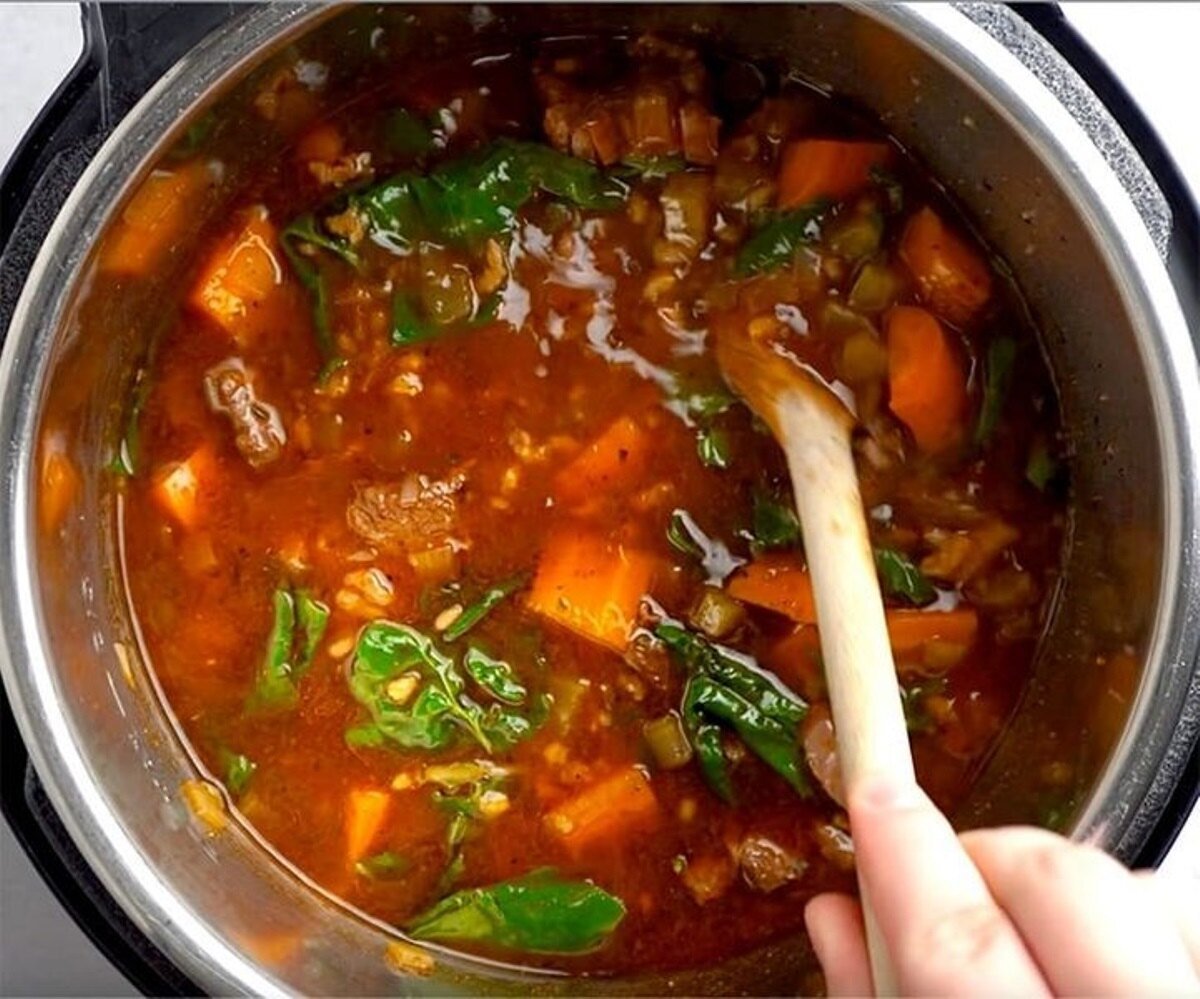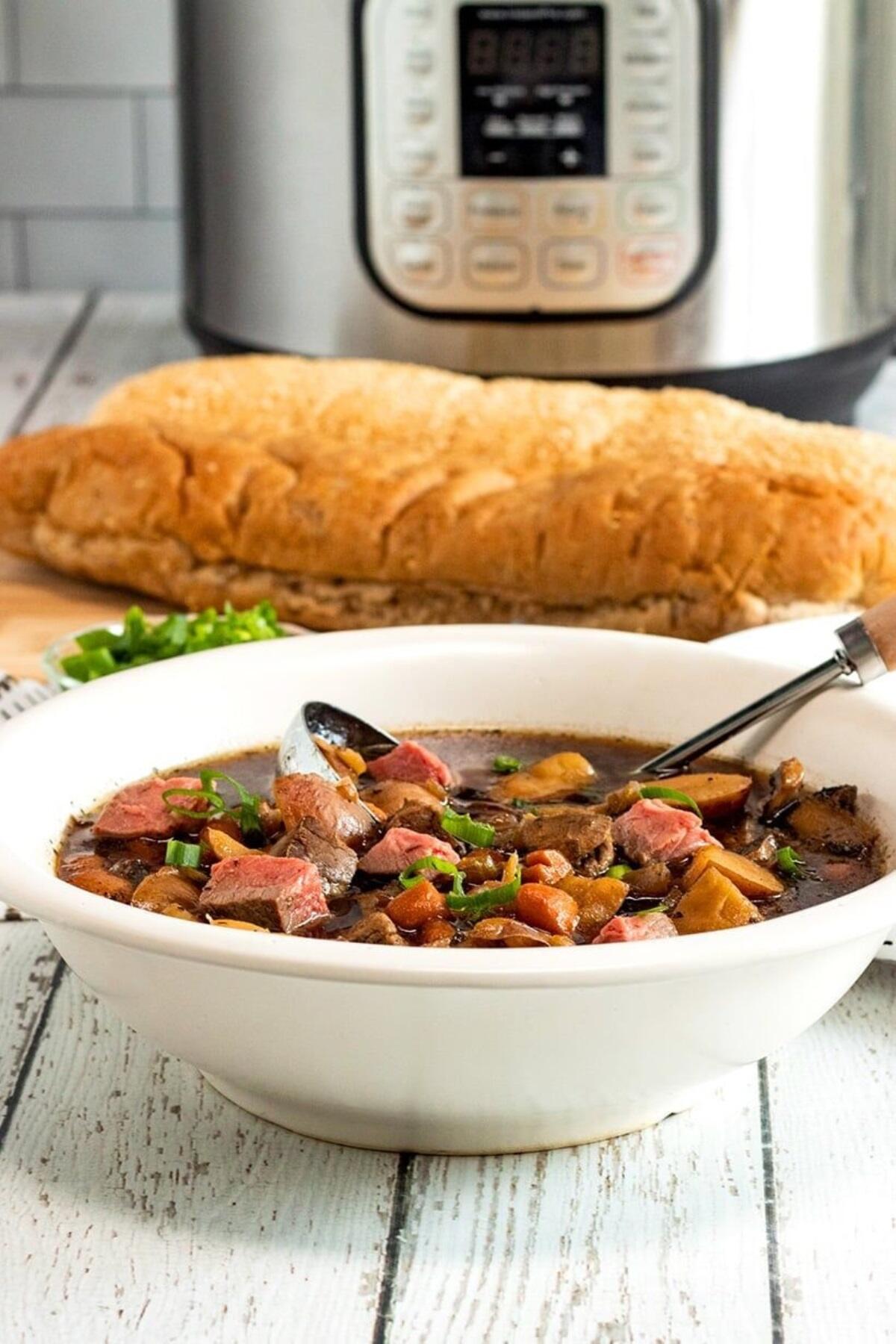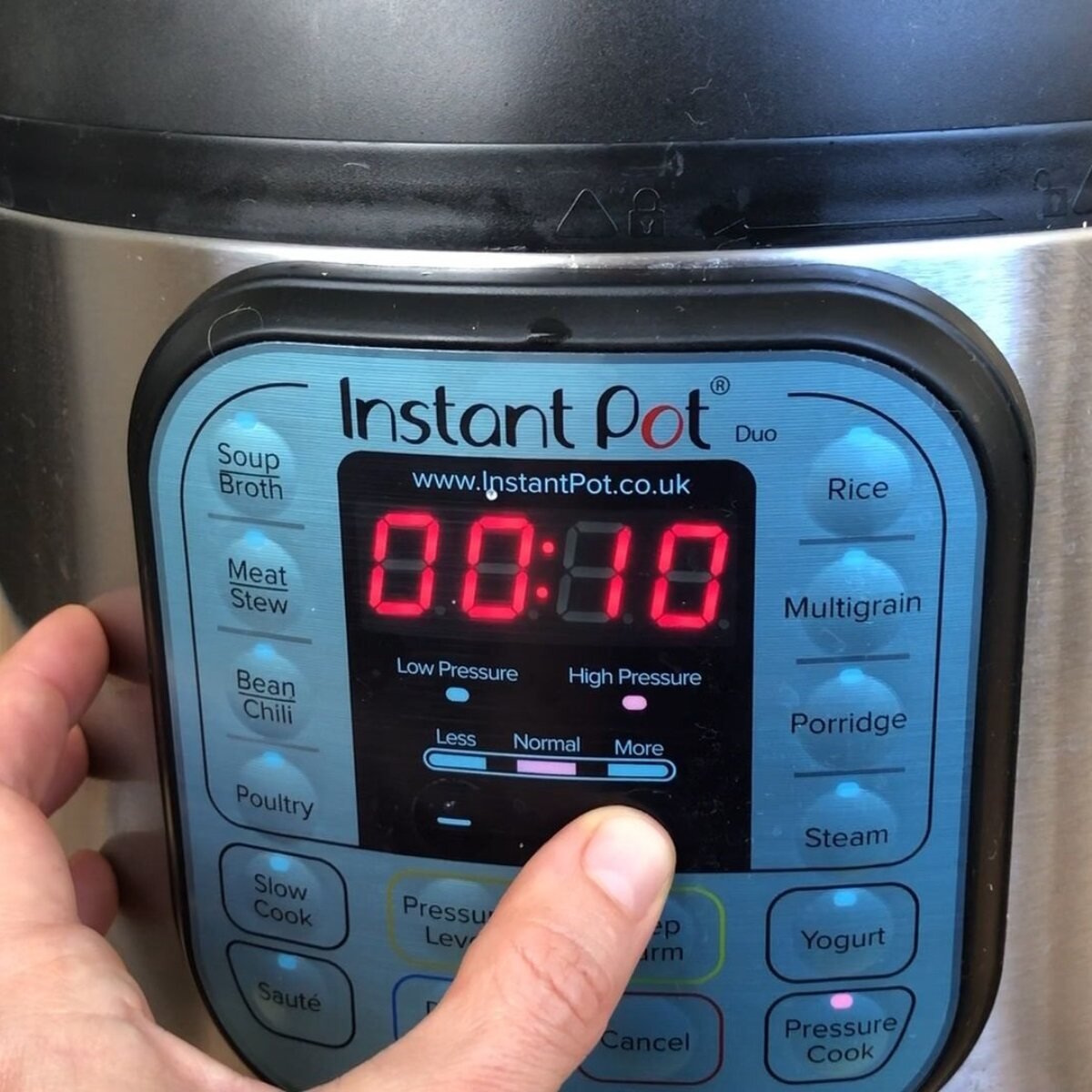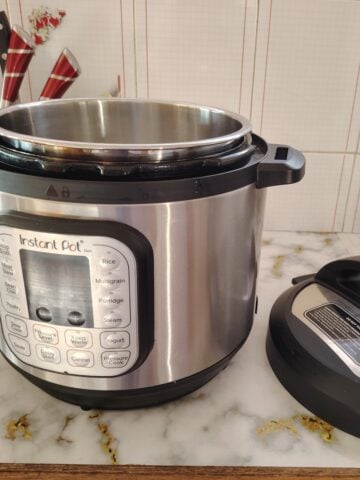
If you’re a busy home cook, you know that reheating soup can be a hassle. But with an Instant Pot, you can easily cook food and reheat your favorite soups in just a few minutes. Whether you’re looking to save time or simply want to enjoy a hot bowl of soup without the fuss, learning how to reheat soup in Instant Pot is a game-changer.
Reheating soup in an Instant Pot pressure cooker is not only quick and easy, but it also helps to preserve the flavor and texture of your soup. With the Instant Pot’s pressure cooking function, you can reheat your soup evenly and thoroughly, ensuring that every bite is just as delicious as the first time around!
Reheating soup in your Instant Pot doesn’t have to be a hassle. Let's break down the straightforward process into manageable chunks, so you can breathe new life into your leftover soup and enjoy a delicious meal in no time!
Jump to:
- What Is the Best Way to Reheat Soup in an Instant Pot?
- Step-by-Step Guide on How to Reheat Soup in an Instant Pot
- How Long Does It Take to Reheat Soup in an Instant Pot?
- Tips for Reheating Soup in an Instant Pot
- Comparing Reheating Soup in an Instant Pot vs Other Methods
- Using the Keep Warm Function When Reheating Soup in an Instant Pot
- Common Mistakes to Avoid When Reheating Soup in an Instant Pot
- FAQ's
- Conclusion
What Is the Best Way to Reheat Soup in an Instant Pot?

When it comes to reheating soup, the Instant Pot pressure cooker is a time-saving appliance. This versatile kitchen appliance not only speeds up the process but also delivers consistently delicious results. Say goodbye to the days of standing over a boiling pot on the stove, stirring, and waiting for your soup to heat up!
Benefits of Using an Instant Pot to Reheat Soup
Using an Instant Pot to reheat soup offers several advantages over traditional methods. First and foremost, it’s incredibly fast. The pressure cooking function allows you to bring your soup to the perfect temperature in just minutes.
Another benefit of using an Instant Pot to reheat soup is that it frees up space on your stovetop. If you’re preparing a multi-course meal or have limited burners, this can be a lifesaver. Simply transfer your leftover soup to the Instant Pot, set it, and forget it until it’s time to serve, enjoying the convenience of having hot soup ready to eat.
Tips for Reheating Soup in an Instant Pot
To achieve the best results when reheating soup in your Instant Pot, keep these tips in mind:
- Add a splash of broth or water to thin out thick soups and prevent scorching.
- Use the pressure cook function for the fastest reheating time.
- Adjust the cooking time based on the volume and thickness of your soup.
- Release pressure carefully to avoid splatters and burns.
- Stir well before serving to redistribute any settled ingredients.
- Cover the pot with the Instant Pot Lid to ensure even reheating and to prevent splatters.
By following these simple tips, you’ll be able to reheat your favorite Instant Pot soup recipes to perfection every time.
Step-by-Step Guide on How to Reheat Soup in an Instant Pot

Now that you know the benefits and tips for reheating soup in an Instant Pot, let’s walk through the process step by step. Consider using the pot-in-pot method by placing a smaller, heat-proof container inside the Instant Pot's insert pot for even reheating. Whether you’re reheating a creamy bisque or a hearty stew, this method will work wonders:
1. Preparing the Soup for Reheating
Begin by giving your leftover soup a good stir. This will help to redistribute any ingredients that may have settled during storage. If your soup contains ground beef, ensure it is evenly distributed to avoid clumping during reheating. If your soup seems particularly thick, add a small amount of broth or water to thin it out slightly.
Transfer the soup to your inner pot, making sure not to fill it more than halfway. This leaves room for the pressure to build safely.
2. Setting the Instant Pot for Reheating Soup
Secure the lid on your Instant Pot and ensure that the valve is set to the sealing position. Select the “Pressure Cook” or “Manual” function, depending on your model. Alternatively, you can use the slow cook function for a gentler reheating process. Set the cook time to 1-2 minutes for thinner soups or 3-4 minutes for thicker, heartier soups.
The Instant Pot will take a few minutes to come to pressure before the cook time begins. Once the timer beeps, indicating that the reheating process is complete, you’re ready for the next step.
3. Releasing the Pressure and Serving the Reheated Soup
When the cook time is up, perform a quick release by carefully turning the valve to the venting position. Allow the steam to escape fully before removing the lid. The Instant Pot is excellent for reheating food quickly and evenly, especially when using the pot in pot method, and ensures your soup is piping hot and ready to serve.
Give your reheated soup a final stir, then ladle it into bowls and serve. If you’re not quite ready to eat, simply replace the lid and use the “Keep Warm” function to maintain the perfect serving temperature until mealtime.
Also read: 9 Common Instant Pot Mistakes And How To Avoid Them
How Long Does It Take to Reheat Soup in an Instant Pot?

One of the biggest advantages of using an Instant Pot to reheat soup is the speed. Reheating leftovers in the Instant Pot is not only fast but also ensures even heating throughout.
While the exact time needed will vary based on the volume and thickness of your soup, most soups can be reheated in just 5-15 minutes from start to finish.
This includes the time it takes for the Instant Pot to come to pressure, the actual cook time of 1-4 minutes, and the quick release of pressure at the end.
Compare this to the 20-30 minutes it often takes to reheat soup on the stovetop, and it’s easy to see why the Instant Pot method is a clear winner!
Tips for Reheating Soup in an Instant Pot

While the basic process for reheating soup in an Instant Pot remains the same, there are a few tips to keep in mind for different types of soups:
- For broth-based soups, like chicken noodle or vegetable soup, use a shorter cook time of 1-2 minutes to avoid overcooking the ingredients.
- When reheating creamy soups, such as potato or broccoli cheddar, add a bit of extra liquid and stir well to prevent curdling.
- If your soup contains pasta or grains, like a minestrone or wild rice soup, you may need to add more broth or water to compensate for any liquid absorbed during storage.
- For soups with mashed potatoes, add extra liquid to maintain a smooth consistency.
By adjusting your reheating method slightly based on the type of soup you’re working with, you’ll be able to achieve the perfect texture and flavor every time. This is especially important when reheating Instant Pot chicken recipes like rotisserie chicken soup.
See this recipe: Instant Pot Potato Soup With Poblano Peppers
Comparing Reheating Soup in an Instant Pot vs Other Methods
While there are several ways to reheat soup, using an Instant Pot is often the most efficient and effective method. The Instant Pot's ability to reheat food quickly and evenly makes it a superior choice. Compared to using a slow cooker or simmering soup on the stovetop, the Instant Pot is much quicker and requires less hands-on attention.
Reheating soup in the microwave, while quick, often results in uneven heating and can leave your soup with hot and cold spots. The Instant Pot, on the other hand, heats soup evenly and thoroughly, ensuring that every spoonful is the perfect temperature. It’s a great alternative to using a regular pot on the stove.
Using the Keep Warm Function When Reheating Soup in an Instant Pot
One of the most convenient features of the Instant Pot is the ability to reheat soup. After your soup has finished reheating using the pressure cooking function, the Instant Pot will automatically switch to Keep Warm mode.
This handy feature maintains your soup at a safe serving temperature without overcooking it. So, if you’re reheating soup ahead of time or want to keep it warm longer throughout a meal, the Keep Warm function is your go-to.
Also read: How To Deglaze Instant Pot In A Few Simple Steps
Common Mistakes to Avoid When Reheating Soup in an Instant Pot

To ensure success when you reheat leftovers, such as soup in your Instant Pot, be sure to avoid these common mistakes:
- Don’t use the Saute function to reheat soup, as this can lead to scorching and uneven heating. Stick with the pressure cooking function for the best results.
- Avoid overfilling the Instant Pot insert. Leaving space for pressure to build is crucial for safety and proper function.
- Remember to release pressure carefully to prevent burns and splatters. Use a long-handled utensil or oven mitt to turn the valve to the venting position.
By steering clear of these pitfalls, you’ll be well on your way to perfectly reheated soup every time.
FAQ's
Absolutely! A glass lid can help trap heat, ensuring even reheating without the pressure seal. Just set it on the pot.
Only a drizzle, about 1-2 tablespoons, can add a hint of richness to your soup as it reheats.
Indeed! Reheat your delicious pot roast in your Instant Pot using the sauté function for 1-3 minutes.
Absolutely safe! Just ensure you stir well to prevent any sticking, and consider using the sauté function for 1-2 minutes.
Absolutely! Use the "saute" function for 1-2 minutes to thaw slightly, then pressure cook as usual for optimal results.
Simple! Place the soup with shredded chicken in the pot, add a splash of chicken stock, and choose the "keep warm" setting for 1-3 hours.
Conclusion
Reheating soup in an Instant Pot is a quick, easy, and effective way to enjoy your favorite soups anytime, anywhere. By following the simple steps outlined in this post, you can reheat your soup to perfection every time, preserving its flavor, texture, and nutritional value.
Soup lovers, rejoice! Mastering the art when you reheat leftovers in your Instant Pot is a culinary hack you won't want to live without. In mere minutes, you can revive last week's frozen soup or today's leftovers, and savor every spoonful like it's the first time.
So, the next time you find yourself with leftover soup in the fridge, don't hesitate to break out your Instant Pot and give this method a try. Your taste buds (and your busy schedule) will thank you!






Leave a Reply